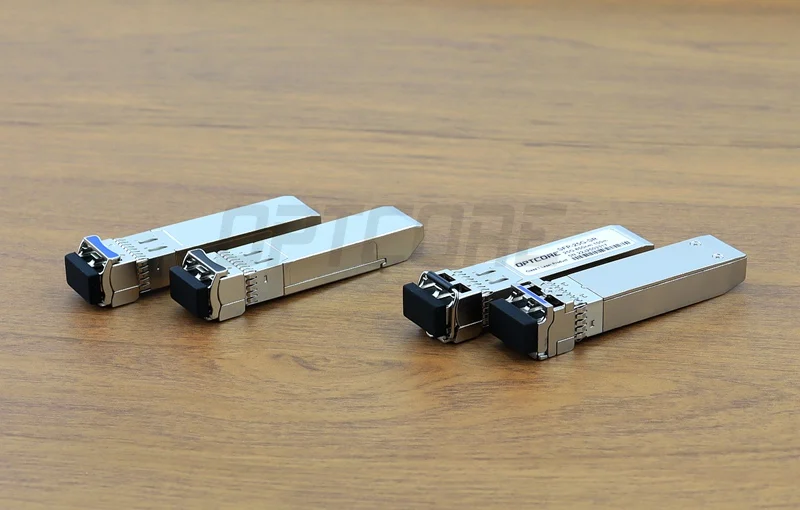In the realm of networking and data communication, the terms SFP and SFP+ are frequently encountered. These compact transceiver modules play a vital role in connecting networking devices, but what sets them apart?
In this article, we will explore the key differences between SFP and SFP+ to help you understand their distinct characteristics and applications.
Physical Form Factor: One of the primary distinctions between SFP and SFP+ lies in their physical form factors. SFP modules are designed to support both fiber optic and copper interfaces and have a data rate of up to 4 Gbps.
On the other hand, SFP+ modules are an enhanced version of SFP modules, exclusively used for fiber optic interfaces, and support data rates of up to 10 Gbps. The SFP+ modules are physically identical to SFP modules but have an enhanced capability to handle higher data rates.
Data Rate: As mentioned earlier, data rate is a significant factor distinguishing SFP from SFP+. SFP modules typically support data rates of 1 Gbps and 4 Gbps, making them suitable for applications where lower bandwidth requirements exist.
SFP+ modules, on the other hand, support data rates of 10 Gbps, allowing for faster and more efficient data transmission. With their increased speed, SFP+ modules are ideal for high-bandwidth applications, such as enterprise networking, data centers, and telecommunications.
Backward Compatibility: Another key difference between SFP and SFP+ is their backward compatibility. SFP modules can operate in SFP+ slots, allowing for compatibility with SFP+ interfaces.
This backward compatibility offers flexibility and cost savings when migrating from lower data rates to higher speeds. However, it is important to note that SFP+ modules cannot be used in SFP slots due to their enhanced capabilities.
Transceivers are designed for specific communication technologies such as wireless, fiber optics, Ethernet, or radio frequency. It’s essential to choose a transceiver that aligns with the intended communication technology.
The physical form factor of a transceiver determines its size, shape, and mounting options. Different applications may require different form factors, such as pluggable modules for network switches or miniaturized modules for compact devices like smartphones.
Therefore, if your networking equipment only supports SFP, you won’t be able to use SFP+ modules without upgrading the hardware.This price difference arises due to the advanced technology and higher data rates supported by SFP+ modules. If your networking requirements can be fulfilled by lower data rates, opting for SFP modules might be a more budget-friendly choice.
Power Consumption: SFP and SFP+ modules differ in their power consumption profiles. SFP modules generally consume less power compared to SFP+ modules. The increased data rates and advanced features of SFP+ modules necessitate higher power requirements.
Therefore, if power efficiency is a critical consideration for your networking infrastructure, SFP modules might be a more suitable choice. However, it’s important to note that the power consumption difference may vary depending on specific module models and manufacturers.
Applications: SFP and SFP+ modules find applications in various networking environments. SFP modules are commonly used in scenarios that require lower data rates, such as traditional LAN setups and lower-density networking equipment.
They are also widely utilized in switches, routers, and network interface cards. SFP+ modules, with their higher data rates, are employed in demanding environments that require increased bandwidth and faster data transmission.One of the primary distinctions between SFP and SFP+ lies in their physical form factors. SFP modules are designed to support both fiber optic and copper interfaces and have a data rate of up to 4 Gbps.
These include data centers, high-performance computing, storage area networks (SANs), and enterprise networking setups.The SFP+ modules are physically identical to SFP modules but have an enhanced capability to handle higher data rates.
Cost Considerations: Cost is an important factor when choosing between SFP and SFP+ modules. Generally, SFP modules are more cost-effective compared to SFP+ modules.
This price difference arises due to the advanced technology and higher data rates supported by SFP+ modules. If your networking requirements can be fulfilled by lower data rates, opting for SFP modules might be a more budget-friendly choice.
Transceivers are often used in various communication systems, such as wireless communication, radio communication, fiber optic communication, and computer networks. They can be found in devices like mobile phones, two-way radios, wireless routers, network switches, and optical networking equipment.
However, if your infrastructure demands higher bandwidth and faster data transmission, the investment in SFP+ modules becomes justified.They are also widely utilized in switches, routers, and network interface cards. SFP+ modules, with their higher data rates, are employed in demanding environments that require increased bandwidth and faster data transmission.
Wrapping it up!
While both SFP and SFP+ modules serve the purpose of connecting networking devices, they differ significantly in terms of data rate, form factor, compatibility, power consumption, applications






